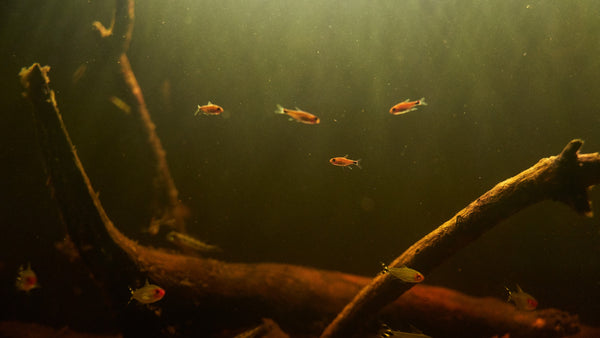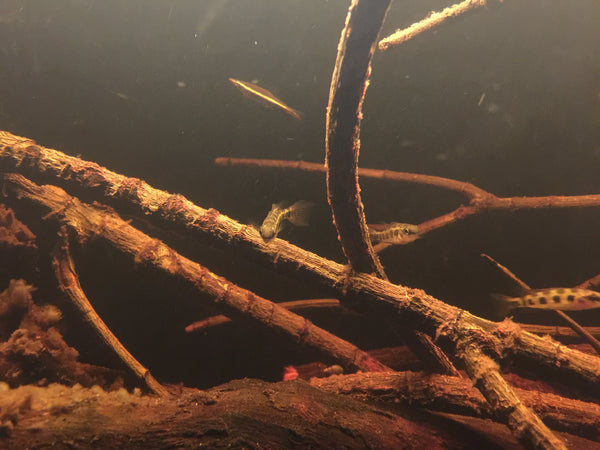- Continue Shopping
- Your Cart is Empty
Where Nature and "style" meet...
I think I am a bit of a taxonomist of sorts, deep down inside. Not in the traditional sense, mind you. However, I have this thing where I love to "classify" stuff- ideas, philosophies, and practices in the hobby...not sure why. I've talked about this with you and with my friends many times over the years here in "the Tint" and elsewhere.

Not too long ago, one of my fave hobbyist/writers/photographers, Sumer Tiwari ( who's pics have graced these pages many times) brought up one of my fave points:
"...In the modern aquarium keeping, we are constantly applauding nature aquarium tanks which are very carefully built to be aesthetic masterpieces. Any newcomer in the hobby is constantly reminded how important “crystal clear” water is. I’m not saying it’s always wrong. There are times when fishes do come from very clear water or maybe you want to go for that look. My concern is that this other side of the hobby’s is often not exposed to the newer generation of the hobbyists.
Hobbyists who are lucky to have visited natural habitats of the fishes they like know and understand this concept very well."
Boom. 💥
Yeah.

Sumer went on to bring up some other very important points in his response, but I want to focus on the topic above for today.
I think that we as a "movement" in the hobby (What I have long called the "Botanical Style" aquarium concept not only present a different sort of aesthetic, but a different mental approach, too. We understand that the materials we place in our aquariums not only affect their appearance, but their function as well.
And these materials change over time, as natural forces and aquatic organisms "work" them...

For decades, I found the truly "ephemeral" nature of the botanical-style aquarium as compelling as any. There was something about it that I couldn't quite place...Now, not everyone found this "look" to be attractive- or even slightly interesting. The near-dominant prevalence of aquatic plants and the rigid interpretation of the so-called "Nature Aquarium Style" movement seemed to leave little room in the hobby's collective psyche for a tinted, darker tank full of randomly-placed decomposing leaves and seed pods and the accompanying biofilms, fungal growth, and occasional turbidity.

Or did it?
I mean, Amano's whole idea in a nutshell was to replicate nature to a certain extent by accepting it and laying a conceptual groundwork for it to unfold. (Just look at all of the pics of grassy fields, old barns in disrepair, and moss-covered fenceposts in Amano's books. He got it.) Now, granted, his general aesthetic involved plants and what seems to be a natural-looking aquascape, although executed in an intentionally artistic way. There is nothing wrong with this. Some of the world's most beautiful aquariums were/are created this way.
However, what I noticed over time in the freshwater aquarium world was an almost obsessive, rigid adherence to certain parts of Amano's formula and aesthetic; specifically, ratios, placement of hardscape and plants, and a certain type of aesthetic formula that one had to replicate in order to gain legitimacy or "acceptance" from the community. It was almost "cult-like", to this outsider.
I really don't think it was Amano's intent.
"Wabi-sabi", the Japanese philosophy which embraces the ephemeral nature of the existence of things, was/is a key concept in Amano's approach, and it still is. I think it fell into a bit of "disuse", though, in the "Nature Aquarium" movement, as aquarists aspired to replicate his works, perhaps trying to by-pass what seemed to be a less exciting -or less immediately rewarding- part of his approach.
How sad.

I think that this is why we have some many "diorama-style" tanks in competitions, and I also think it's why we see more and more serious aquascapers taking another look at a more realistic type of aquarium utilizing botanicals. I think many are simply tired of overly-stylized and are leaning back into a truly more natural look.

Is there not also tremendous beauty in "randomness", despite our near-obsessive pursuit of rules, such as "golden ratio", color aggregating, etc? Just because last year's big 'scaping contest winner had the "perfect" orientation, ratios, and alignment of the (insert this year's trendiest wood here) branch within the tank, doesn't mean it's a real representation of the natural functionality of "randomness."
In other words, just because it looks good, it doesn't mean it's what Nature actually looks like. Or acts like, for that matter.

Yes, I know an aquarium is not "Nature"- but it does function in accordance with Nature's laws, regardless of what we want, right? It can't skirt those, no matter what label we assign to it, or no matter how much we value certain aspects of it.
One of the things that we've noticed lately in the hobby is a trend towards more "realistic" aquariums. Not just systems which look like natural environments; rather, systems which are modeled as much after the function of them as the aesthetics.
"Functional aesthetics."

I think this is where Tannin Aquatics falls, if you had to nail us down into one specific "stylistic/philosphical approach" to aquariums.
The "Space Between", so to speak. It's exactly what we were created for- to support this area of interest in every way possible.
A less rigidly aesthetically-controlled, less "high-concept" approach to setting the stage for...Nature- to do what she's done for eons without doing as much to "help it along." Rather, the mindset here is to allow Nature to take it's course, and to embrace the breakdown of materials, the biofilms, the decay...and rejoice in the ever-changing aesthetic and functional aspects of a natural aquatic system- "imperfect" though they may seem to some-and how they can positively affect our fishes.

Wabi-Sabi? Yeah, I think so.
The initial skepticism and resistance to the idea of an aquarium filled with biofilms, decomposition, and tinted water has given way to enormous creativity and discovery. Our community has (rather easily, I might add!) accepted the idea that Nature will follow a certain "path"- parts of which are aesthetically different than anything we've allowed to occur in our tanks before- and rather than attempting to mitigate or thwart it, we're celebrating it!
It's less about perfect placement of materials for artistic purposes, and more about placing materials to facilitate more natural function and interactions between fishes and their environment.
We are looking more and more at the natural habitats for inspiration, rather than "last month's Tank of The Month"- which is a huge leap towards unlocking a greater understanding and appreciation for nature. And towards preserving it. It's amazing how much you respect and treasure a natural habitat when you have a miniature replica of it in your living room, isn't it?

We are in a really cool place, where we can inspire, assist, and learn from everyone from the most hardcore biotope aquarist to the recovering Nature Style addict, to the serious fish breeder, and show them a way to really incorporate a different side of nature into their aquariums.
And you can embrace both "style" and Nature, as we've seen many times from members of our community.

We're seeing that not only do botanicals, leaves, and alternative substrate materials look interesting- they provide a physiological basis for creating unique environmental conditions for our fishes and plants. We're seeing fish graze on the life forms which live in and among the decomposing botanicals, as well as the botanicals themselves- just like in nature...And we are seeing the influence- aesthetically and chemically- that these materials assert on the aquarium's environmental parameters.

It's not just a look. Not just an aesthetic. Not just a mindset.
It's a way to incorporate natural materials to achieve new and progressive results with the fishes and plants we've come to love so much. It's still early days. A ground floor opportunity for every aquarist who gives this stuff a shot to make a meaningful- and beautiful contribution to the evolving state of the art of the botanical-style blackwater/brackish aquarium., and to share unique representations of what Nature really looks like with people all over the world.

Welcome.
Stay thoughtful. Stay bold. Stay innovative. Stay excited. Stay curious. Stay diligent...
And Stay Wet.
Scott Fellman
Tannin Aquatics
4 Responses
Scott Fellman
Hey Keith!
Well said; I couldn’t put these words any better myself. I think if more hobbyists make this mental shift, the hobby experience for many will be so much better!
Enjoy the journey…
Scott
Keith
What a refreshing and shared perspective! I first started keeping aquariums in the mid 1980’s, and like most aquarists, I’ve grown and developed my craft and techniques. I’ve also seen trends come and go in cycles. The current trend in meticulous, intricate “scapes” produces aesthetically eye-catching aquariums also creates a double-edged sword. People want this instant gratification of a beautifully, perfect aquarium, yet they seem to forget aquariums, terrariums, paludariums, are dynamic, evolving systems. Nature is not static, so why do we expect our creations to be as well? Plants will compete against each other, decay will happen, or fish may become territorial. Nature has a chaotic orderliness to it. Wabi sabi is it’s mantra. Instead of fighting with frustration against this, accept it as part of the natural process – part of the path to discovery and learning. If people set up an aquarium to bring a slice of nature inside, why do they become disheartened and fight against natural forces when it doesn’t do what they want it to?
Scott Fellman
Hey Dan,
Good to see you experimenting. Trust me, our substrate formula is every bit as messy as yours, I’ll bet! It’s definitely not a “neat, tidy, crystal-clear water” kind of thing…But it works great!
Scott
Dan
The substrate sounds great. I wish you had announced that a few days earlier, I’ve made own botanical substrate for an Igapo biotope and it’s so messy!










Scott Fellman
Author